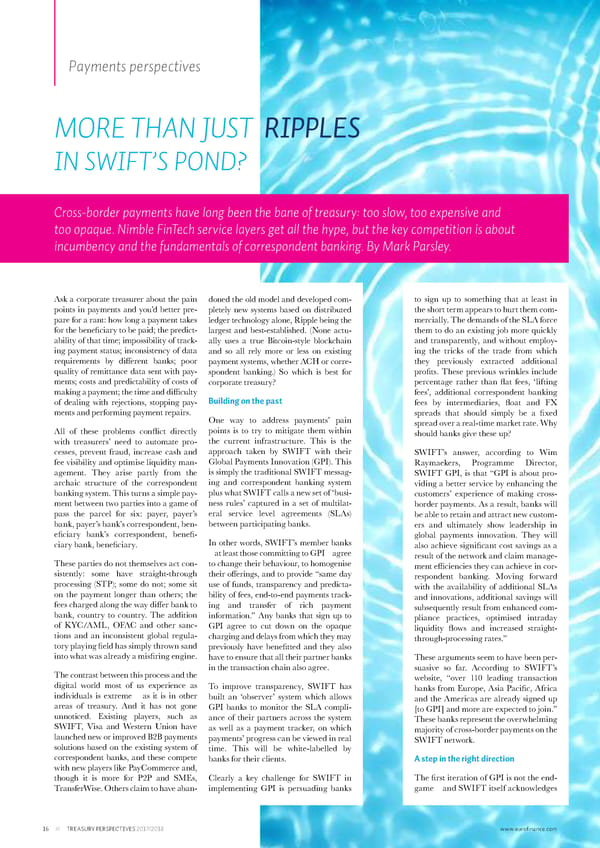Payments perspectives MORE THAN JUST RIPPLES IN SWIFT’S POND? Cross-border payments have long been the bane of treasury: too slow, too expensive and too opaque. Nimble FinTech service layers get all the hype, but the key competition is about incumbency and the fundamentals of correspondent banking. By Mark Parsley. Ask a corporate treasurer about the pain doned the old model and developed com- to sign up to something that at least in points in payments and you’d better pre- pletely new systems based on distributed the short term appears to hurt them com- pare for a rant: how long a payment takes ledger technology alone, Ripple being the mercially. The demands of the SLA force for the beneficiary to be paid; the predict- largest and best-established. (None actu- them to do an existing job more quickly ability of that time; impossibility of track- ally uses a true Bitcoin-style blockchain and transparently, and without employ- ing payment status; inconsistency of data and so all rely more or less on existing ing the tricks of the trade from which requirements by different banks; poor payment systems, whether ACH or corre- they previously extracted additional quality of remittance data sent with pay- spondent banking.) So which is best for profits. These previous wrinkles include ments; costs and predictability of costs of corporate treasury? percentage rather than flat fees, ‘lifting making a payment; the time and difficulty fees’, additional correspondent banking of dealing with rejections, stopping pay- Building on the past fees by intermediaries, float and FX ments and performing payment repairs. One way to address payments’ pain spreads that should simply be a fixed All of these problems conflict directly points is to try to mitigate them within spread over a real-time market rate. Why with treasurers’ need to automate pro- the current infrastructure. This is the should banks give these up? cesses, prevent fraud, increase cash and approach taken by SWIFT with their SWIFT’s answer, according to Wim fee visibility and optimise liquidity man- Global Payments Innovation (GPI). This Raymaekers, Programme Director, agement. They arise partly from the is simply the traditional SWIFT messag- SWIFT GPI, is that “GPI is about pro- archaic structure of the correspondent ing and correspondent banking system viding a better service by enhancing the banking system. This turns a simple pay- plus what SWIFT calls a new set of ‘busi- customers’ experience of making cross- ment between two parties into a game of ness rules’ captured in a set of multilat- border payments. As a result, banks will pass the parcel for six: payer, payer’s eral service level agreements (SLAs) be able to retain and attract new custom- bank, payer’s bank’s correspondent, ben- between participating banks. ers and ultimately show leadership in eficiary bank’s correspondent, benefi- global payments innovation. They will ciary bank, beneficiary. In other words, SWIFT’s member banks also achieve significant cost savings as a – at least those committing to GPI – agree result of the network and claim manage- These parties do not themselves act con- to change their behaviour, to homogenise ment efficiencies they can achieve in cor- sistently: some have straight-through their offerings, and to provide “same day respondent banking. Moving forward processing (STP); some do not; some sit use of funds, transparency and predicta- with the availability of additional SLAs on the payment longer than others; the bility of fees, end-to-end payments track- and innovations, additional savings will fees charged along the way differ bank to ing and transfer of rich payment subsequently result from enhanced com- bank, country to country. The addition information.” Any banks that sign up to pliance practices, optimised intraday of KYC/AML, OFAC and other sanc- GPI agree to cut down on the opaque liquidity flows and increased straight- tions and an inconsistent global regula- charging and delays from which they may through-processing rates.” tory playing field has simply thrown sand previously have benefitted and they also into what was already a misfiring engine. have to ensure that all their partner banks These arguments seem to have been per- The contrast between this process and the in the transaction chain also agree. suasive so far. According to SWIFT’s digital world most of us experience as To improve transparency, SWIFT has website, “over 110 leading transaction individuals is extreme – as it is in other built an ‘observer’ system which allows banks from Europe, Asia Pacific, Africa areas of treasury. And it has not gone and the Americas are already signed up GPI banks to monitor the SLA compli- [to GPI] and more are expected to join.” unnoticed. Existing players, such as ance of their partners across the system These banks represent the overwhelming SWIFT, Visa and Western Union have as well as a payment tracker, on which majority of cross-border payments on the launched new or improved B2B payments payments’ progress can be viewed in real SWIFT network. solutions based on the existing system of time. This will be white-labelled by correspondent banks, and these compete banks for their clients. A step in the right direction with new players like PayCommerce and, though it is more for P2P and SMEs, Clearly a key challenge for SWIFT in The first iteration of GPI is not the end- TransferWise. Others claim to have aban- implementing GPI is persuading banks game – and SWIFT itself acknowledges 16 // TREASURY PERSPECTIVES 2017/2018 www.eurofinance.com
 Who's Running the Treasury? Page 15 Page 17
Who's Running the Treasury? Page 15 Page 17